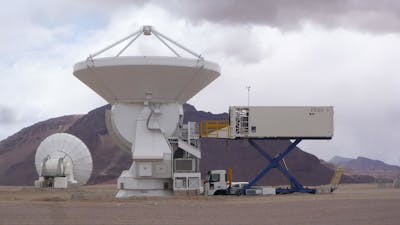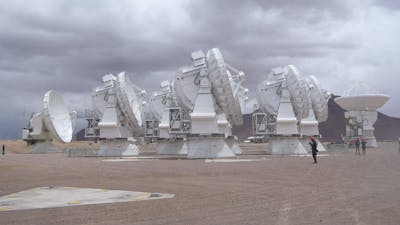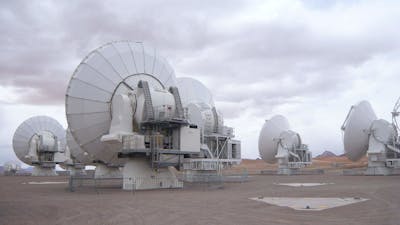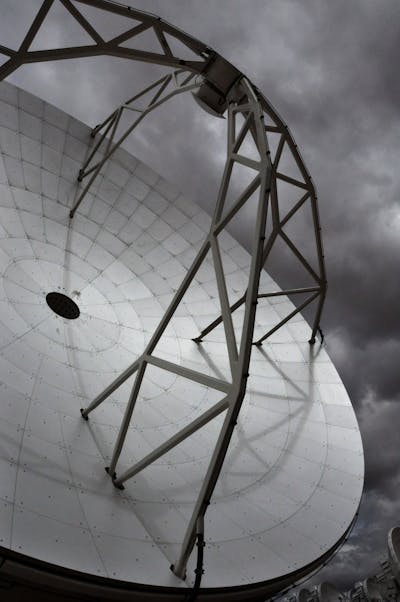Atop a high tower, as far as possible from Earth, there sits a human being who has altered his eyes through gigantic optical aids in such a way that they are capable of penetrating outer space as far as the most distant stars. In its environment, suns and planets circle at a solemn pace. Even swift-footed light takes millions of years to penetrate this environment space. And yet this whole environment is only a tiny excerpt from Nature, tailored to the capacities of the human subject.
Jakob von Uexküll, A Foray into the Worlds of Animals and Humans, 1934.1
Chile, and in particular the Atacama Desert’s region, has been repeatedly labeled astronomy’s paradise.2 According to a recent survey, Chile currently hosts 42% of the world’s astronomical observatories while by 2018 it will be home to 70% of worldwide astronomy infrastructure, or, following a different estimate, Chile will engender half of the world’s astronomical images by 2025. Chile’s attractiveness to astronomers is mainly justified by its extraordinary and extreme geography. The Atacama Desert, which covers about 128,000 square kilometres (49,000 sq. mi) of Chile’s territory, is the driest and possibly the oldest desert on earth, having experienced hyperaridity for 3 million years. The average rainfall in the Atacama is 15 millimetres per year. However, some of the weather stations located in the area have never registered rain, and skies are clear 300 days per year. Situated at the west of the Andes Mountains, the desert reaches unusual altitudes and doesn’t suffer from major dust storms. Moreover, the very widely spaced settlements in the region guarantee almost inexistent light pollution and radio interference. Such extreme aridity and minimal pollution of course create ideal conditions for astronomical observations, and the international scientific community has heavily invested in the Atacama Desert, especially since the 1990s when, with the return to democracy and the stabilization of the political climate, Chile emerged as one of the most secure and flourishing states in South America.3
In the words of a representative of the European Southern Observatory (ESO, a 15-nation intergovernmental research federation), economical and political stability are essential to the long time, significant investments required to install the new generation of gigantic astronomical observatories. In a 2011 interview, ESO’s spokesman focused on three existing or projected schemes located in the Atacama Desert: the Very Large Telescope (VLT), fully operational since 2000; the European Extremely Large Telescope (E‑ELT), on which construction began in June 2014; and the Atacama Large Millimeter/submillimeter Array (ALMA), now in an advanced phase of development. The construction of ALMA, the world’s largest complex of radio telescopes, which has been working at full potential since 2013 (even if the last of the antenna did not arrive until June 2014), required the combined forces of European, North American and East Asian scientific institutions together with the cooperation of the Republic of Chile.4
ALMA sits at 5,000 metres over the sea, on a vast plateau of the Chilean Andes. The complex is serviced and manned by engineers, technicians, drivers, mechanics and controllers in charge of assuring the smooth flow and processing of astounding amounts of data. An astronomer may sit in the research station, in spaces in which oxygen is regularly pumped to supplement the scarcity at high altitude. But most often astronomers will sit far away, in remote countries, in front of computer screens transcribing and interpreting information transmitted by the gigantic “hearing” aids that compose ALMA. Sounds are actually registered by the sixty-six dish-shaped 12-meter and 7‑meter antennas slowly turning around in synchronic movement in an eerie mechanical ballet, but astronomers would seldom “listen” to the signals received from far away stars and galaxies. Astronomers would rather look at the strings of numbers digitized by the sensitive receivers that amplify the radio signals collected by the antenna dishes. Astronomers would then, in collaboration with engineers and artists, transform, enhance, filter and manipulate data which extremely powerful computers and apposite programs have already screened and altered. The final results will be mesmerizing images and animated renderings of cosmic objects and processes unbelievably beyond human perception.
ALMA has a resolution 10 times bigger than the legendary Hubble Space Telescope, launched into Earth orbit by NASA in 1990. Nevertheless, it will be surpassed by the Square Kilometre Array (SKA) projected to be completed by 2024 between South Africa and Australia. According to design, SKA will have 50 times the resolution of ALMA. Of course, much can be said about the severe conditions imposed on humans and machines by the extreme environments in which these overwhelming and exponentially growing observation technologies are deployed, although even more astonishing is to reflect on how the data they collect are translated, interpreted, presented, and circulated. In fact, what such gigantic apparatuses produce are images, which are posted almost daily on the website of each observatory, not to speak of innumerable scientific papers, reports, grant applications, research proposals, or works of vulgarization like picture books and even calendars.
But what is the character of these images? Clearly they cannot be considered faithful copies, mechanical reproductions, or “objective” representations of cosmic objects and events so fundamentally beyond the grasp of human perception no matter how technologically enhanced. And looking at these images will require even more of an act of faith, like the one suggested by Bruno Latour in his famous essay on iconophilia: “Iconophilia is respect not for the image itself but for the movement, the passage, the transition from one form of image to another. By contrast, idolatry would be defined by attention to the visual per se. Thus, iconoclasm may be defined either as what attacks idolatry or as what destroys iconophilia, two very different goals. Because it seems so difficult to resist the temptation inherent in all images — that is, to freeze-frame them — the iconoclast dreams of an unmediated access to truth, of a complete absence of images. But if we follow the path of iconophilia, we should, on the contrary, pay even more respect to the series of transformations for which each image is only a provisional frame. In other words, we should be iconophilic in all domains at once: in art, in science, and in religion.”5
In the last section of a book that retraces the history of the notion of “objectivity” in science, epistemologists Lorraine Daston and Peter Galison define the most recent generation of scientific images as presentations rather than representations. In their words, in the digital scientific atlases of today (including astronomical ones), images operate as tools, rather than evidence, and are used to make and change things. Digital images are, at least partially, interactive: they can be rotated, correlated, flied through, zoomed, coloured, and cut. Digital images present (rather than represent) in a triple sense: first, instead of portraying what already exists, they become “part of a coming-into-existence”; second, images are “produced to entice – scientifically and entrepreneurially,” to promise things that exist only in incomplete or fictional form; and finally, liberated from the constraint of mechanical objectivity, they easily merge with artistic presentation.6
Daston and Galison’s theses are revisited, expanded and refined by Elizabeth Kessler in a recent painstaking analysis of the spectacular cosmic images “fabricated” with extremely sophisticated digital technologies that manipulate and interpret data sent to Earth by the Hubble Space Telescope. Tellingly titled Picturing the Cosmos: Hubble Space Telescope Images and the Astronomical Sublime, the study demonstrates how the compelling images regularly circulated by the astronomical research institutions controlling Hubble operate as a “hybrid of science, art, and public relations.” From fragmented signals that need to be carefully separated from noise and black and white pictures of extremely hazy and distant celestial bodies, teams of engineers, artists, and astronomers produce the most seductive and colorful images that, as Kessler convincingly demonstrates, are uncannily similar in composition, palette selection, and study in contrasts to the celebrated “sublime” landscape paintings of the American West realized during the nineteenth century by artists such Albert Bierstadt and Thomas Moran.7 Astronomers often refer to these sorts of representations as “pretty pictures”, a formula implying a negative connotation. Nevertheless, they cannot deny the seductive powers of the images and the way they beautifully function not only inside the scientific community but also at large, on the lay public, who almost inevitably responds to them as to “true” depictions of the universe.

© UMWELT (Scheidegger and Garcia Partarrieu). Reproduced with permission.

© UMWELT (Scheidegger and Garcia Partarrieu). Reproduced with permission.

© UMWELT (Scheidegger and Garcia Partarrieu). Reproduced with permission.

© UMWELT (Scheidegger and Garcia Partarrieu). Reproduced with permission.

© UMWELT (Scheidegger and Garcia Partarrieu). Reproduced with permission.

© UMWELT (Scheidegger and Garcia Partarrieu). Reproduced with permission.
The photographs presented here were taken by UMWELT (Scheidegger & Garcia Partarrieu) and Gerardo Köster during a fieldtrip and workshop organized by the AA School (London) and titled Chile by Night. Directed by Pedro Ignacio Alonso (School of Architecture, Pontificia Universidad Católica de Chile, Santiago), the workshop took place in January 2013. Tutors and collaborators included Thomas Weaver (AA School, London), Pilar Cereceda (geographer, Pontificia Universidad Católica de Chile), Francisco Förster and Elise Servajean (astronomers, Universidad de Chile, Santiago), Ignacio Garcia Partarrieu and Arturo Scheidegger (UMWELT Architects, Santiago de Chile), and Alessandra Ponte (School of Architecture, Université de Montréal). Special thanks are due to Pedro Ignacio Alonso for gaining access to ALMA and to Francisco Förster and Elise Servajean for introducing us to the complexities of astronomy’s extreme forms of imaging.
Review
By Nicholas de Monchaux
The essay above draws a profound architectural diagram. First, the lateral extension of the vast array, which the facts of physics allow to masquerade as a single, continent-spanning dish. And then, the great, sectional sweep, from below-ground infrastructure, through the wires and arteries of the telescope’s proliferating gantries, and out — far out — into the celestial void.
This is a vast section in space. But, vis-à-vis Einstein, a section in time as well. For while it is received and parsed by what the telescope authorities announce as the “world’s fastest supercomputer,” the signal arrives over ages first, the vast distance of space equating precisely to eons of time. As outlined above, these images then continue to change and operate through the world, mirroring the steady flux in society and ecology that produces our culture, one in which only transformation is fixed.
And here, the dream of a specific image and potential tool. When it is finally completed, the resolution of the ALMA array will be sufficient not just to picture (as has already been examined) the prehistoric formation of stars and galaxies but, at a finer depth, it is planned, to “directly image exo-planets, possibly discovering the first traces of life.”8
The discovery of life on other planets would go a step towards solving the Fermi paradox (named after the famed Italian physicist who conceived it at a dinner-party). We are, as far as we have measured, the only ones in the cosmos who are not just alive but also producing structure and civilization.9 And so, absent the creator, we are the universe’s only architects. This might be — the paradox states — because we are spectacularly unique. Or, equally, because we are, unfortunately, not. Which is to say that all technological, planetary civilizations might (as we are currently threatening to do) make themselves extinct almost as quickly as they emerge, by transforming and degrading the ecology that supports them.
Indeed, our transformation of the natural cycles of our own planet started (one can convincingly argue) with the very sands that support the vast array. After the exhaustion of the guano-encrusted islands, whose nitrogen-rich layers supported the 19th century’s vast expansion in agricultural output, it was only the discovery of even larger deposits of nitrogen in the vast, dried seabed of the Atacama that avoided a massive economic and social catastrophe.10 Until the discovery of the Haber-Bosch process for fixing Nitrogen from the air in 1911, the Atacama was the global engine, not only of life-giving agriculture but also of its corollary shadow, the manufacture of gunpowder, arms, and bullets with which fertilizer shares essential chemistry.
A section through this architecture and this desert is then also, perhaps, this: at its base, in the lifeless dirt, our anxieties about the many natural cycles our technology has shaped and remade to our ultimate peril. And at its apex, in the stars, our hopes of picturing not just the presence of life on planets throughout the deep universe, but also its continued presence, as we know it, here on Earth.
Notes
1
Jakob von Uexküll, A Foray into the Worlds of Animals and Humans with A Theory of Meaning (Streifzüge durch die Umwelten von Tieren und Menschen, 1934), translated by Joseph D. O’Neil, introduction by Dorion Sagan, afterword by Geoffrey Winthrop-Young (Minneapolis, MN/London, UK: University of Minnesota Press, 2010), 133.
2
See, for example, “Why Chile is an astronomer’s paradise,” Gideon Long, BBC News, July 24, 2011: www.bbc.co.uk/news/world-latin-america-14205720
3
For a beautiful and poetic interpretation of the Atacama Desert as privileged space for astronomy but also as political space of repression and erasure of memory during Augusto Pinochet’s dictatorship, see Nostalgia for the Light (Nostalgia de la Luz), a documentary released in 2010 by Patricio Guzmán.
4
ALMA is funded in Europe by the European Southern Observatory (ESO), in North America by the U.S. National Science Foundation (NSF) in cooperation with the National Research Council of Canada (NRC) and the National Science Council of Taiwan (NSC), and in East Asia by the National Institutes of Natural Sciences (NINS) of Japan in cooperation with the Academia Sinica (AS) in Taiwan. ALMA construction and operations are led on behalf of Europe by ESO, on behalf of North America by the National Radio Astronomy Observatory (NRAO), which is managed by Associated Universities, Inc. (AUI), and on behalf of East Asia by the National Astronomical Observatory of Japan (NAOJ).
5
Bruno Latour, “How to be Iconophilic in Art, Science, and Religion,” in Peter Galison and Caroline A. Jones, eds., Picturing Science, Producing Art (New York, NY/London, UK: Routledge, 1998), 421.
6
Lorraine Daston and Peter Galison, Objectivity (New York, NY: Zone Books, 2007), 383 – 4.
7
Elizabeth A. Kessler, Picturing the Cosmos: Hubble Space Telescope Images and the Astronomical Sublime (Minneapolis, MN/London, UK: University of Minnesota Press, 2012).
8
http://www.almaobservatory.org/en/about-alma, accessed 9/4/15.
9
See Michael H. Hart, “Explanation for the Absence of Extraterrestrials on Earth,” Quarterly Journal of the Royal Astronomical Society 16 (1975): 128 – 135.
10
See Vaclav Smil, Enriching the Earth: Fritz Haber, Carl Bosch, and the Transformation of World Food Production (Cambridge, MA: The MIT Press, 2001).
- Tags
- placelandscapetechnologyphotography
Biographies
Alessandra Ponte is a professor at the École d’architecture, Université de Montréal, where she teaches history and theory of architecture and landscape. She has also taught at Pratt Institute, Princeton University, Cornell University, the Istituto Universitario di Architettura di Venezia, and ETH (Zurich). Ponte is the author of Le paysage des origines: “Le voyage en Sicile” (1777) de Richard Payne Knight (Les Éditions de l’Imprimeur, 2000) and co-editor, with Antoine Picon, of Architecture and the Sciences: Exchanging Metaphors (Princeton Architectural Press, 2003). A collection of her essays was published in 2014 as The House of Light and Entropy (Architectural Association Publications). Ponte organized the exhibition Total Environment: Montréal 1965 – 1975 (Canadian Centre for Architecture, Montréal, 2009) and both co-organized and co-edited the catalogue for the exhibition God & Co.: François Dallegret Beyond the Bubble (Architectural Association, London, 2011; ETH, Zurich, 2012; ENSBA-Malaquais, Paris, 2012). Since 2009, she has been responsible for the conception and organization of the Phyllis Lambert Seminar, annual colloquia on contemporary architectural topics. Email: alessandraponte@sympatico.ca
Nicholas de Monchaux is an architect, urban designer, and theorist. Since 2006, he has been a faculty member in the College of Environmental Design, University of California, Berkeley, where he teaches architecture and urban design. De Monchaux’s book Spacesuit: Fashioning Apollo (MIT Press, 2011) was awarded the Eugene Emme award from the American Astronautical Society. His design work has been exhibited at the Biennial of the Americas, the Venice Architecture Biennale, SPUR (San Francisco), and the San Francisco Museum of Modern Art; it has also received awards and citations from Parsons The New School for Design, the International Union of Architects, Pamphlet Architecture, and the Van Alen Institute. Prior to independent practice, de Monchaux worked with Michael Hopkins & Partners (London) and Diller, Scofidio + Renfro (New York). De Monchaux’s work has been supported by the Graham Foundation for Advanced Studies in the Fine Arts, the Hellman Family Fund, the Santa Fe Institute, and the Smithsonian Institution. He is a Fellow of both the American Academy in Rome and the MacDowell Colony. Email: demonchaux@berkeley.edu





